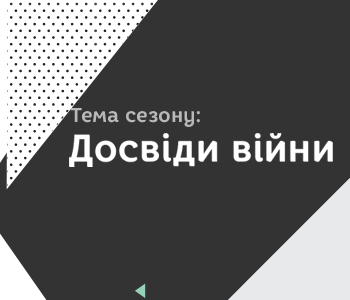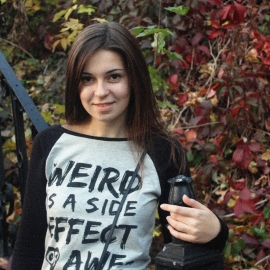The 1991 USSR collapse did not assume the end of everything Soviet. The new states inherited elements of the Soviet culture, mentality, consciousness, everyday practices and, of course, stereotypes. All this has required careful reflection and revision. Gender prejudices assimilated in the previous era are still part of our daily lives. We often reproduce them without realizing their origin. What, for example, was the female image and gender roles in the Soviet culture?
In the USSR, there were two stereotypes regarding male and female social roles. The Soviet constitution guaranteed equal opportunities regardless of gender[1]. In practice, however, gender roles were quite traditional: men were engaged in management, science, and industry, and women were primarily concerned with household duties and child raising, combining them with earning money. The second stereotype assumed that women were “second-class” workers since they claimed benefits due to their family responsibilities[2]. Thus, the official Soviet rhetoric had to simultaneously foster gender equality and condemn everything that hindered it. Hence, even ideological texts indirectly recognized gender inequality.
Before the start of “perestroika” in 1985, official Soviet rhetoric moved from denying its own inconsistency with the everyday perception of a woman’s place in society to accepting it. Eventually, doublethink (a state in which a person simultaneously holds opposite views[3]) became characteristic of the USSR society. It allowed for the existence of any contradictions between the officially declared and the unofficially existing and valid state of things.
The contradictions between the ideology and the actual gender stereotypes were particularly evident on the pages of Soviet magazines of satire and humor. “Krocodil” (“Crocodile”), “Perets” (“Pepper”), “Vozhyk” (“Hedgehog”), “Chayan” (“Scorpion”), and other satirical publications were to become the “weapon of the party” and fight social defects using humor. That was the role assigned to satire and humor in the USSR[4].
Male and female readers alike perceived cartoons, feuilletons, and sketches as entertainment. Hence, the editorial boards of satirical magazines had to balance humor as a means of educating Soviet citizens and humor that would meet readers’ expectations, that is would be funny and plain. Thus, official humor involuntarily approached its competitor — an informal laughing culture, such as anecdotes, in which gender stereotypes were an almost mandatory element.
Comic writers had to rely on typical images since they guaranteed recognition and achievement of a laughing effect. Therefore, in the Stagnation Period, censored satire got increasingly closer to folklore in terms of themes, forms, and, of course, use of gender stereotypes. The process was enhanced by the male composition of humorous magazines’ editorial boards. This was also the case of the “Perets” magazine, of which we shall talk here.
“Perets” is a Ukrainian magazine of satire and humor published since 1941 (its predecessor, “Chervonyi Perets” (“Red Pepper”), was officially closed in 1934). During the Stagnation Period, this publication became one of the leading “serious” publications and one of the most popular magazines in Soviet Ukraine with a circulation of 3 million copies. According to Fedir Makivchuk, the long-time editor-in-chief of “Perets,” in 1977 each magazine issue was read by at least 15 million readers[5]. “Perets,” on the one hand, undermined cultural norms and stereotypes, but on the other hand — reflected them, because any cultural phenomenon is a product of its environment and is also able to affect it.
The primary question that arises here is how important gender issues were for “Perets” creators and how often comic writers indicated the gender of satirical works’ characters. The situation differed for texts and cartoons.
In feuilletons and sketches, the character’s gender was rarely emphasized with only name and surname being indicated. This was mostly done to connect a social problem to an individual and to depict a negative phenomenon as a local abuse of power rather than a social crisis.
In cartoons, artists had to draw a character as either male or female. The analysis of male and female characters use reveals a ratio of 80:20. This ratio mostly remained unchanged until 1991, which once again proves that gender stereotypes were strongly embedded in society, even in official rhetoric. If comic writers portrayed a typical social problem, it was mainly associated with a typical bearer, that is males.
Males more often than females were depicted as negative characters and reflected social defects. Women mostly appeared as neutral or positive characters, victims of local abuse of power. However, this only proved the tendency to portray men as more socially active.
The more a satirical work character was involved in social processes related to management, industry, or creativity, the more problems he embodied. Satire is a sharp humor that ridicules some flaws. Though “Perets” was to reproduce the official gender policy of equality, the magazine’s pages tended to reflect patriarchal society. Was it always so and in what contexts were female images used?
FEMALE WORKERS OF THE STALIN ERA
In the Stalin Era ( the mid-1920s — early 1950s), when “Perets” appeared, the Soviet regime was actively imposing a single ideology on society and portrayed the desired future rather than the harsh reality. “Perets” authors strived to break the stereotype of the secondary role of women in the industry and public life. Women were portrayed as the best factory workers, record-breaking milkmaids, students, deputies etc. Plan overfulfillment even turned into a “character trait” that boys appreciated in girls[6].
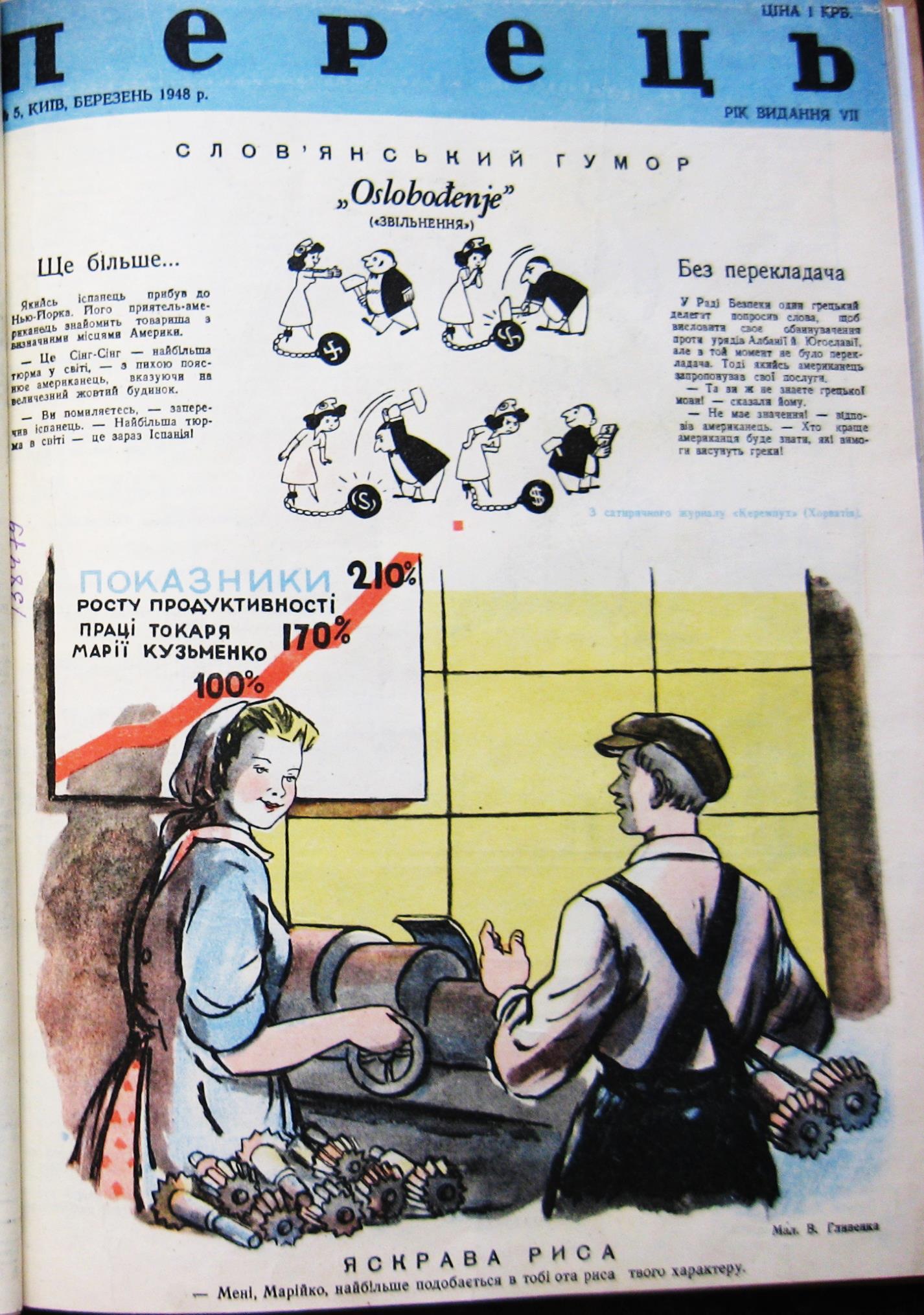
Image of an industry record breaker in the Stalin Era
Quite often, the Stalin Era cartoons combined an image of a socially active woman and traditional values. Women were portrayed as bearers of Ukrainian culture. A great example is the cover of the 1948 “Perets” magazine depicting Soviet Ukraine[7]. The Ukrainian SSR was portrayed as a female metallurgist, miner, and collective farmer. The latter image represented Ukraine as something traditional and agrarian to the readers.
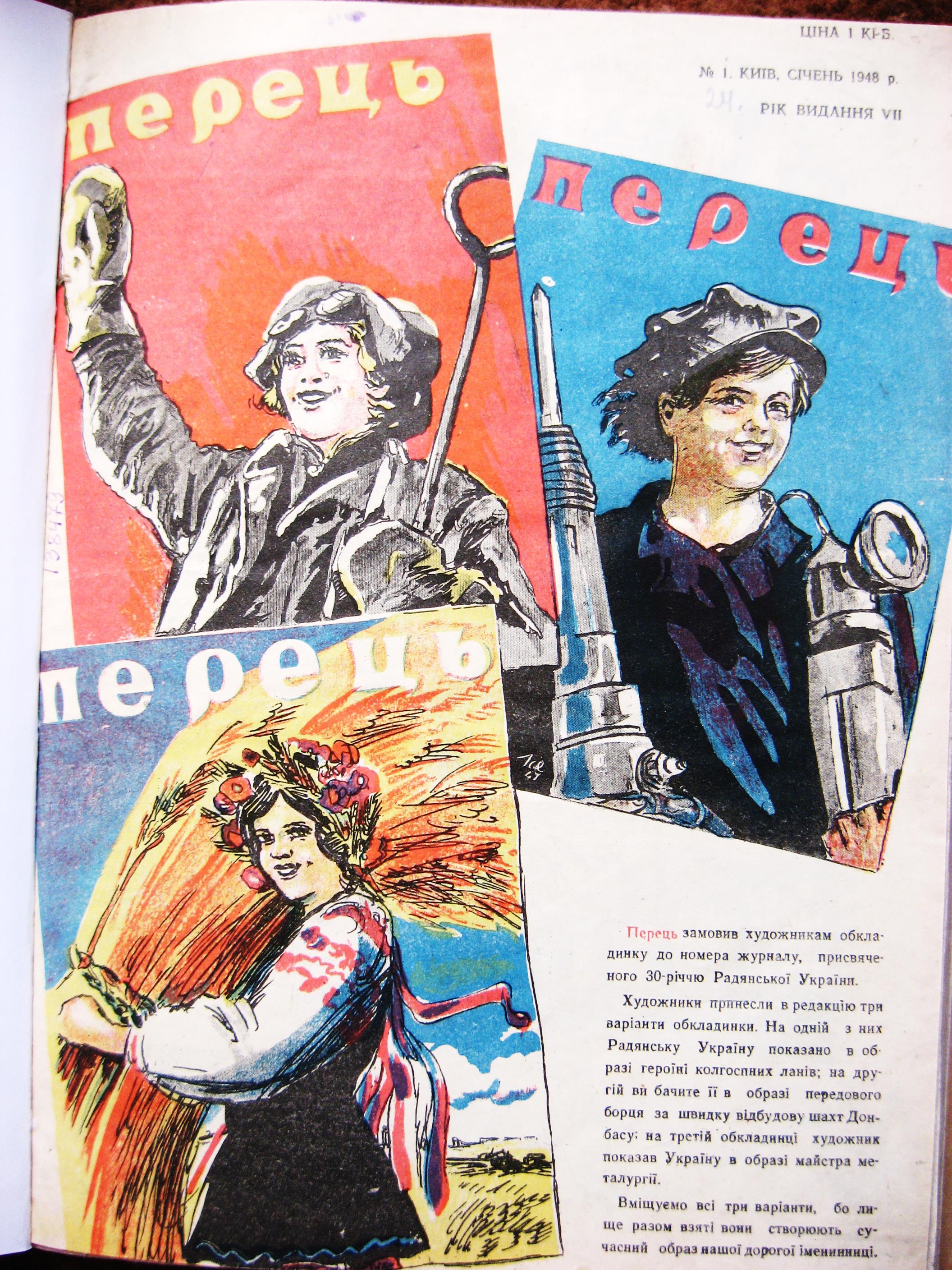
Ukraine depicted as a female miner, metallurgist, and collective farmer
GENDER POLICY OF THE STAGNATION PERIOD (1965–1985)
Gradually, Soviet ideology began to lose its implementation contexts. For example, during the Stagnation Period (“Zastoi”) — namely, in 1965-1985 — such crucial events of Soviet mythology as the Bolshevik Revolution and the World War II were mostly mentioned on respective anniversaries. These topics appeared on magazine and newspaper covers. On other days, the press, radio, and television generally focused on typical everyday problems. The same was true for the images of record-breaking female workers, scientists, and occasionally female directors — women “emancipated by the Soviet regime.” Obviously, March 8 became the day to remember the achievements of the Soviet regime gender policy[8].
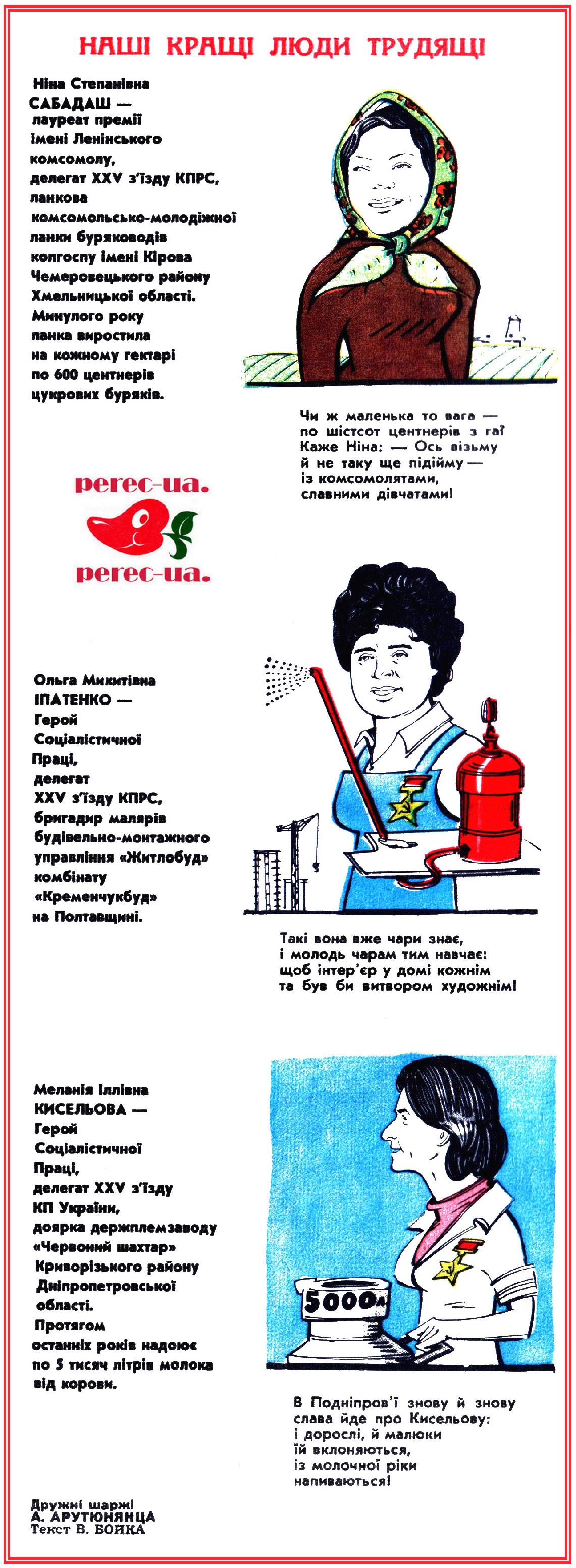
March 8 friendly cartoons of labor heroines
Generally, the fifth issue of “Perets” (which was published twice a month) was dedicated to March 8 or Shevchenko’s Day (in the case of anniversary). By the Stagnation Period, stories in which women were fighting for their rights had almost disappeared from the holiday issues. Comic writers formally placed friendly cartoons of female record breakers in the industry the sector, and then embedded the holiday in the domestic context. The holiday issue covers were filled with household stories in which males and females switched their stereotypical roles. Therefore, in many cartoons, on March 8 a husband unsuccessfully strived to do “women’s work” in the kitchen “on this day”[9].

Changing stereotypical male and female roles regarding household duties on March 8
These stories, aimed to entertain readers on the holiday, emphasized the stereotypical division of male and female roles. A husband washing dishes and a wife feeling her superiority (even in domestic context) were exceptional stories only typical for March 8. Another story actively developed in holiday cartoons and texts was that of a husband’s gifts to his wife. A stereotypical gift set included flowers, chocolates, and perfumes[10].
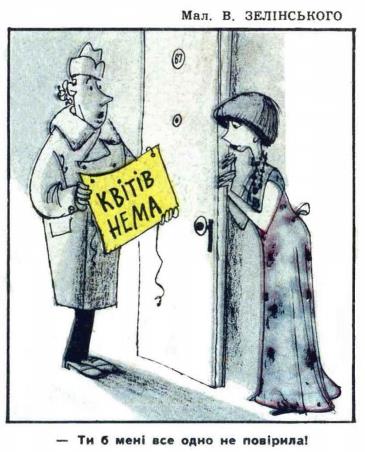
March 8 gifts
Performance of “female duties” by males and standard gifts made up a typical set of March 8 “rituals,” which lost their original sense in the 1970s-1980s. The humorous magazine relying on typical images emphasized this trend.
In the 1960s-1980s, not only the March 8 image, but also the majority of female images moved into the domestic sphere. It was in domestic topics that entertaining humor, full of gender stereotypes, was generally used. Hence, women were mostly portrayed as wives, mothers, or grandmothers engaged in housekeeping, clothing and hairstyles, and child raising[11].
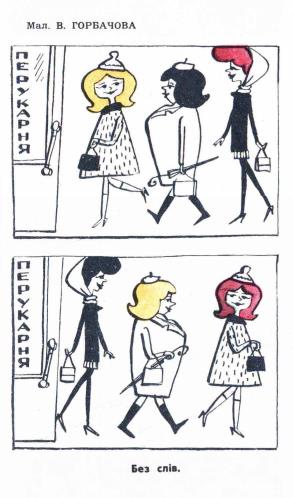
Searching for a personal style in a Soviet way
Of course, comic writers sometimes tried to rethink the unfair distribution of gender roles and ridicule men avoiding household chores and child raising[12]. However, the ambiguous role of humor has always assumed we could come to terms with the problem we ridicule because laughter relieves stress and helps to “vent.” Therefore, strange as it may seem, ridiculing gender stereotypes can often lead to an opposite effect — strengthening of stereotypes in our minds.
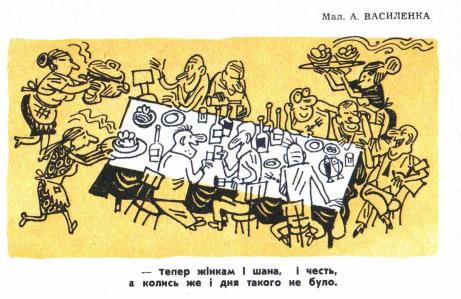
Women and household duties
To satirically rethink gender distribution of roles, comic writers sometimes swapped places between men and women at the household level, not only in the March 8 context. For example, in the “Pictures of the primitive men life” section Gerasymchuk depicted family relations in the age of matriarchy when a man cooking food and looking after children complains of a woman who has just come home from work and immediately sat down to read a stone newspaper with a cigarette in her mouth[13].

“In the age of matriarchy”
Household humor in “Perets” used to play an entertaining role as opposed to such “serious” topics as foreign policy or industrial issues. Official humor often strived to use elements of folklore or pseudo-folklore (jokes actually invented by professional comic writers). In “Perets” such texts were included in the “Folk Jests” section. The stories of these “jests” unfolded in traditional agrarian society to prove their folk background. Hence, they ridiculed noblemen, clergy, and family relations. For example:
A father to his son:
“Happy you are, son!”
“Why’s that, dad? My wedding’s tomorrow.”
“That’s why, son...”[14]
Satirical works, in which women were portrayed as purely domestic characters, often regarded such issues as improper child raising, conflict of generations, male alcoholism, excessive consumption etc.
It was men that were generally blamed for family troubles. Satirists ridiculed irresponsible society members who abandoned their wives and children and sought happiness with other women[15]. Typically, the husband’s new love interest was portrayed as more attractive compared to the abandoned wife depressed with household duties and child raising and trying to get her husband back.
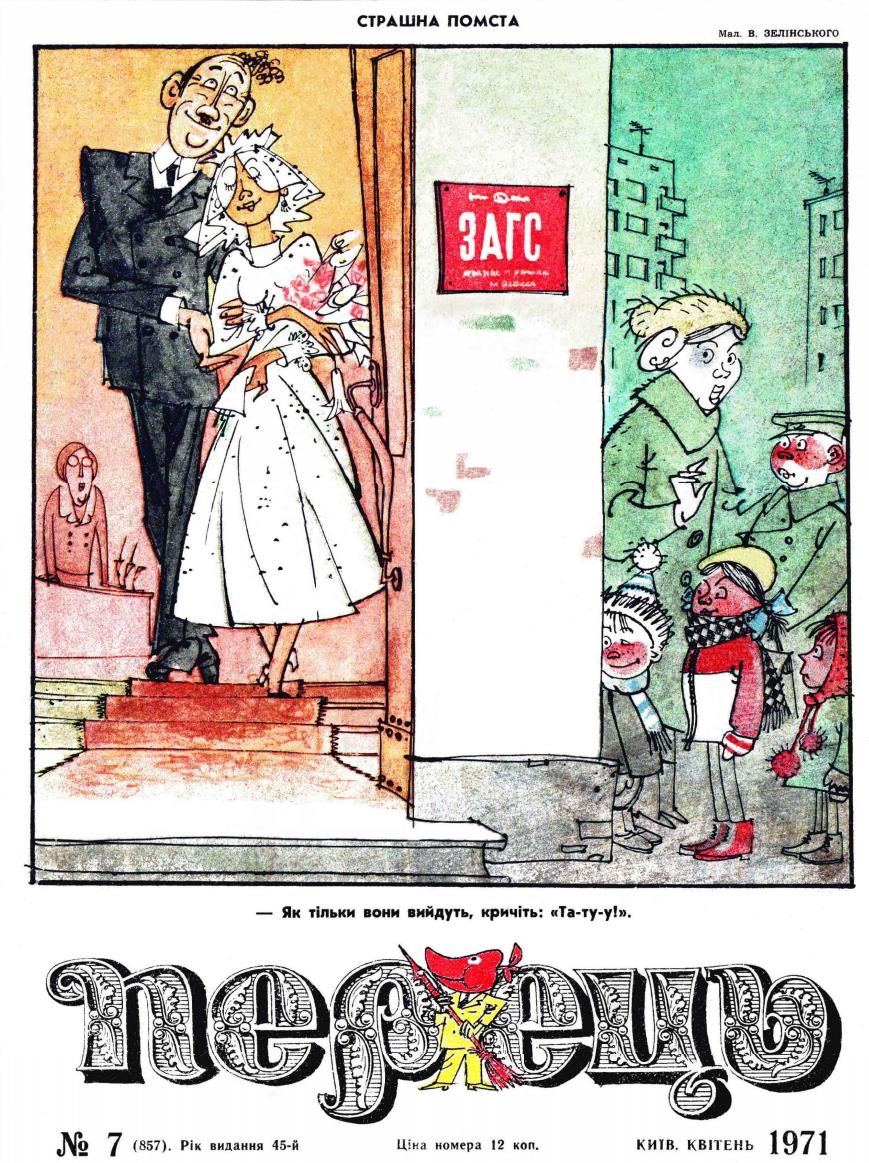
Image of an abandoned wife with her children
Images of an unhappy wife and mother often served as a background for criticism of alcoholism (male one in the vast majority of cases). A chronically drunk father, who spoils the life of a hard-working woman raising children, is a typical story[16].
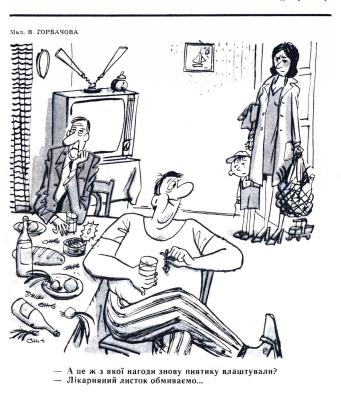
Gender aspects of domestic alcoholism
Women could also be portrayed as irresponsible mothers; still, it was not that a bad mother and an exemplary father were opposed in these stories, but a married couple was depicted as poor parents. Most often, such parents delegated their child raising functions to either institutions or relatives, mainly grandmothers. In this case, it was not the genders that were opposed, but the generations, and the older generation was stereotypically drawn as an elderly woman. To emphasize the abnormality of such family relationships, careless parents were “rewarded” with other negative traits, such as excessive consumption or passion for foreign clothing brands and equipment. The same was true for adult children, who, regardless of gender, did not understand why they needed a grandmother[17].
The most stereotypical professions associated with female images beyond the March 8 context included secretaries, teachers, cleaners, and, of course, saleswomen. The latter got the most typical features of unattractive females: impolite persons aiming to scold buyers (usually men)[18].
Within these professions, “Perets” enabled women to not only dominate men, but also humiliate them. Like, for example, a cleaner in the sketch “Deficit Profession,” hints at the exceptional importance of her profession and the futility of institute engineers[19, or waitresses considering themselves restaurant owners[20].
Such a situation, when, depending on the context, one gender dominates over and often humiliates the other, could be hardly called healthy gender relations, even if the latter issue was not raised in a humorous work.
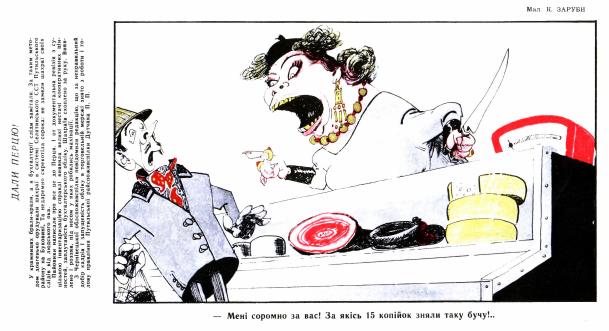
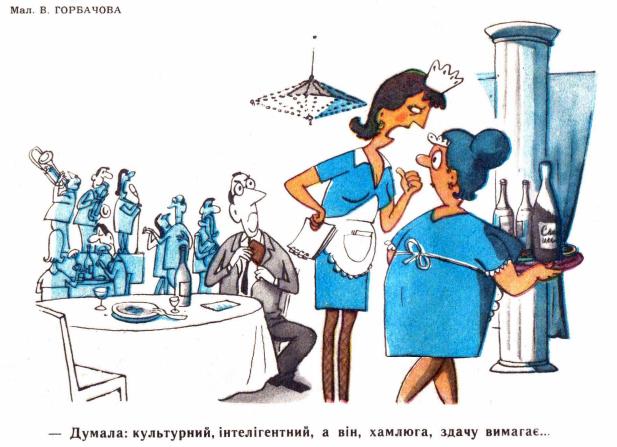
Stereotypical female professions
Negative female characters mainly appeared in the context of fashion (especially Western or meaningless ones in the view of the magazine’s authors[21]) or strife to successfully get married. Both stories were combined in cartoons that grotesquely depicted fashionistas marrying elderly men out of a desire to have dream products (primarily vehicles)[22].
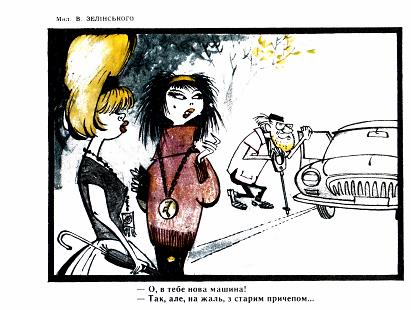
Marriage of convenience
“PERESTROIKA” AND SEXUAL REVOLUTION
The Era of Perestroika in satirical publications gave rise to another context for female images portrayal. This was a sexual revolution[23], which took place in the official Soviet culture after the decades of a ban on erotica in literature, cinema, and the press.
The sexual revolution mainly involved exposure of female body, which was depicted in the same cartoons as dressed men and was the object of desire. If, for example, in “Krocodil” a partly naked woman was just a background for jokes, in “Perets” an undressed woman mostly appeared in the context of acute social problems (trade deficit or prostitution) new to official satire[24].
SO WHAT’S TODAY?
Even “bold” official Soviet rhetoric demonstrated the patriarchal principles of the Soviet culture inherited by the post-Soviet society. The “Perets” magazine was published in traditional paper format until 2014 and after its closure and attempts to publish it again, went online. Since the late 1980s, the magazine’s staff has been looking for a new format and content to adapt to the new political realities and has achieved considerable success despite a sharp decline in popularity (the magazine, probably, could not compete with new media and failed to get rid of its stereotypical connection to the Communist Party). Having changed the objects of ridicule in politics, the magazine still continued to create humor using strong stereotypes regarding the role of women in society, their normative behavior, and appearance. Such Soviet legacy failed to become subject to revision since it was not on top of social transformations.
Modern laughing culture reproduces gender stereotypes reinforced by the Soviet everyday life: predominantly domestic context of female activities, primary perception of women as sexual objects, and their secondary role (compared to men) in intellectual, cultural, and social terms. In addition, the image of a female victim, on which attention is focused through humor, is reproduced and thus the desire to fight gender inequality is reduced, because one of the functions of humor is to relieve stress, “vent,” and sublimate. In other words, by ridiculing a negative phenomenon, we partially forgive it. No wonder most radical movements aimed at a radical social change strived to avoid entertaining laughter, instead relying on exposing humor.
Humor is entertainment that still reproduces social ills and stereotypes, including gender ones. When we laugh at a joke, we relax and can easily assimilate and partially accept sexism and inequality. The Soviet authorities to instil their ideology in the population once used this function of humor. That is how humor works today, especially with regard to gender.
Does that mean we cannot laugh and joke? Not at all! Laughter and humor are something inherent in man and culture. So just be careful and if a joke contains gender stereotypes or elements of sexism and discrimination, remember that refusing to accept such jokes will clearly demonstrate your views and serve to form a like-minded community (i.e. take the powerful integrative function of humor), establishing new social rules and regulations.
I invite readers to share their observations about humor that reflects gender issues in social networks, publications, and just in everyday communication. Where exactly have you heard and read jokes using gender stereotypes? Can they be considered dangerous? Can we create “counter-jokes” on gender stereotypes and can humor be a weapon against sexism?
[1] Конституція СРСР 1936 року: http://www.tarasei.narod.ru/konst1936.htm Конституція СРСР 1977 року: http://www.tarasei.narod.ru/konst1977.htm
[2] Див.: Баскакова М. Равные возможности и гендерные стереотипы на рынке труда. — М.: МЦГИ, 1998.
[3] Див.: Фирсов Б. Разномыслие в СССР. 1940–1960-е годы: история, теория и практики. — СПб.: Изд-во Европейского университета в СПб., Европейский дом, 2008.
[4] Див.: Єремєєва К. «Перчити і приперчувати!»: завдання радянських сатиричних видань (на прикладі журналу «Перець») // Український історичний журнал. — 2018. — № 1. — C. 127.
[5] Центральний державний архів-музей літератури і мистецтва України. — Ф. 668. — Оп. 1. — Спр. 231. — Арк. 1.
[6] Гливенко В. Карикатура // Перець. — 1948. — № 5. — С. 1.
[7] Карикатура // Перець. — 1948. — № 1. — С. 1.
[8] Напр.: Арутюнянц А., Бойко Ю. Наші кращі люди трудящі // Перець. — 1977. — № 5. — С. 3.
[9] Арутюнянц А. Карикатура // Перець. — 1977. — № 5. — С. 1; Монастирський О. Карикатура // Перець. — 1980. — № 5. — С. 16.
[10] Зелінський В. Карикатура // Перець. — 1978. — № 5. — С. 1.
[11] Горбачов В. Без слів // Перець. — 1970. — № 5. — С. 9.
[12] Василенко А. Карикатура // Перець. — 1970. — № 5. — С. 9.
[13] Герасимчук С. У період матріархату // Перець. — 1976. — № 10. — С. 5.
[14] Найщасливіший день // Перець. — 1980. — № 10. — С. 11.
[15] Зелінський В. Страшна помста // Перець. — 1971. — № 7. — С. 1.
[16] Горбачов В. Карикатура // Перець. — 1974. — № 10. — С. 4.
[17] Арутюнянц А. Внуки здивовані... // Перець. — 1982. — № 17. — С. 5.
[18] Заруба К. Карикатура // Перець. — 1965. — № 10. — С. 5.
[19] Круковець О. Дефіцитна професія // Перець. — 1974. — № 1. — С. 6.
[20] Горбачов В. Карикатура // Перець. — 1972. — № 14. — С. 6.
[21] Див.: Корнієнко О. Періодика УРСР 1950-1980-х рр. як інструмент впливу на моду та повсякденне життя // Вісник ХНУ ім. В. Н. Каразіна. Серія «Історія України. Українознавство: історичні та філософські науки». — Харків, 2018. — Вип. 27. — С. 77–88.
[22] Зелінський В. Карикатура // Перець. — 1965. — № 10. — С. 5.
[23] Див.: Зіньчук С. «Оголений погляд на гласність»: гендерні аспекти сексуального перевороту в друкованих виданнях середини 1980 — початку 1990-х років // Гендерна політика очима української молоді: ХІІІ Регіональний науковий конкурс молодих учених. — Харків: ХНУМГ ім. О. М. Бекетова, 2019. — С. 45–57.
[24] Василенко А. Карикатура // Перець. — 1989. — № 5. — С. 2.

